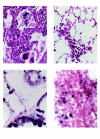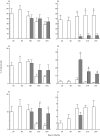Immunological and pathological comparative analysis between experimental latent tuberculous infection and progressive pulmonary tuberculosis
- PMID: 11985512
- PMCID: PMC1906395
- DOI: 10.1046/j.1365-2249.2002.01832.x
Immunological and pathological comparative analysis between experimental latent tuberculous infection and progressive pulmonary tuberculosis
Abstract
Mycobacterium tuberculosis produces latent infection or progressive disease. Indeed, latent infection is more common since it occurs in one-third of the world's population. We showed previously, using human material with latent tuberculosis, that mycobacterial DNA can be detected by in situ PCR in a variety of cell types in histologically-normal lung. We therefore sought to establish an experimental model in which this phenomenon could be studied in detail. We report here the establishment of such a model in C57Bl/6 x DBA/2 F1 hybrid mice by the intratracheal injection of low numbers of virulent mycobacteria (4000). Latent infection was characterized by low and stable bacillary counts without death of animals. Histological and immunological study showed granulomas and small patches of alveolitis, with high expression of tumour necrosis factor alpha (TNFalpha), inducible nitiric oxide synthase (iNOS), interleukin 2 (IL-2) and interferon gamma (IFNgamma). In contrast, the intratracheal instillation of high numbers of bacteria (1 x 106) produced progressive disease. These animals started to die after 2 months of infection, with very high bacillary loads, massive pneumonia, falling expression of TNF-alpha and iNOS, and a mixed Th1/Th2 cytokine pattern. In situ PCR to detect mycobacterial DNA revealed that the most common positive cells in latently-infected mice were alveolar and interstitial macrophages located in tuberculous lesions, but, as in latently-infected human lung, positive signals were also seen in bronchial epithelium, endothelial cells and fibroblasts from histologically-normal areas. Our results suggest that latent tuberculosis is induced and maintained by a type 1 cytokine pattern plus TNFalpha, and that mycobacteria persist intracellularly in lung tissue with and without histological evidence of a local immune response.
Figures



 ) and latent infection (□). Pooled results from two experiments, each with eight mice, are expressed as the mean and standard deviation. Asterisks indicate statistical significance (P < 0·005). (a) IL-2; (b) IL-4; (c) TNF; (d) IL-1; (e) iNOS; (f) BCG.
) and latent infection (□). Pooled results from two experiments, each with eight mice, are expressed as the mean and standard deviation. Asterisks indicate statistical significance (P < 0·005). (a) IL-2; (b) IL-4; (c) TNF; (d) IL-1; (e) iNOS; (f) BCG.
Similar articles
-
Analysis of the local kinetics and localization of interleukin-1 alpha, tumour necrosis factor-alpha and transforming growth factor-beta, during the course of experimental pulmonary tuberculosis.Immunology. 1997 Apr;90(4):607-17. doi: 10.1046/j.1365-2567.1997.00193.x. Immunology. 1997. PMID: 9176116 Free PMC article.
-
Alphabeta T cell receptor-positive cells and interferon-gamma, but not inducible nitric oxide synthase, are critical for granuloma necrosis in a mouse model of mycobacteria-induced pulmonary immunopathology.J Exp Med. 2001 Dec 17;194(12):1847-59. doi: 10.1084/jem.194.12.1847. J Exp Med. 2001. PMID: 11748285 Free PMC article.
-
Role of tumor necrosis factor-alpha in Mycobacterium-induced granuloma formation in tumor necrosis factor-alpha-deficient mice.Lab Invest. 1999 Apr;79(4):379-86. Lab Invest. 1999. PMID: 10211990
-
Pathology of post primary tuberculosis of the lung: an illustrated critical review.Tuberculosis (Edinb). 2011 Nov;91(6):497-509. doi: 10.1016/j.tube.2011.03.007. Epub 2011 Jul 6. Tuberculosis (Edinb). 2011. PMID: 21733755 Free PMC article. Review.
-
The immunological aspects of latency in tuberculosis.Clin Immunol. 2004 Jan;110(1):2-12. doi: 10.1016/s1521-6616(03)00210-9. Clin Immunol. 2004. PMID: 14986673 Review.
Cited by
-
The PGRS Domain from PE_PGRS33 of Mycobacterium tuberculosis is Target of Humoral Immune Response in Mice and Humans.Front Immunol. 2014 May 27;5:236. doi: 10.3389/fimmu.2014.00236. eCollection 2014. Front Immunol. 2014. PMID: 24904584 Free PMC article.
-
WhiB5, a transcriptional regulator that contributes to Mycobacterium tuberculosis virulence and reactivation.Infect Immun. 2012 Sep;80(9):3132-44. doi: 10.1128/IAI.06328-11. Epub 2012 Jun 25. Infect Immun. 2012. PMID: 22733573 Free PMC article.
-
Mycobacterium tuberculosis infection of the 'non-classical immune cell'.Immunol Cell Biol. 2015 Oct;93(9):789-95. doi: 10.1038/icb.2015.43. Epub 2015 Mar 24. Immunol Cell Biol. 2015. PMID: 25801479 Review.
-
Bifurcation analysis of a tuberculosis progression model for drug target identification.Sci Rep. 2023 Oct 16;13(1):17567. doi: 10.1038/s41598-023-44569-7. Sci Rep. 2023. PMID: 37845271 Free PMC article.
-
Human lung epithelial cells contain Mycobacterium tuberculosis in a late endosomal vacuole and are efficiently recognized by CD8⁺ T cells.PLoS One. 2014 May 14;9(5):e97515. doi: 10.1371/journal.pone.0097515. eCollection 2014. PLoS One. 2014. PMID: 24828674 Free PMC article.
References
-
- Parrish NM, Dick JD, Bishai WR. Mechanisms of latency in Mycobacterium tuberculosis. Trends Microbiol. 1998;6:107–12. - PubMed
-
- Kochi A. The global tuberculosis situation and the new control strategy of the World Health Organization. Tubercle. 1991;72:1–6. - PubMed
-
- Wayne LG. Dormancy of Mycobacterium tuberculosis and latency of disease. Eur J Clin Microbiol Infect Dis. 1994;13:908–14. - PubMed
Publication types
MeSH terms
Substances
LinkOut - more resources
Full Text Sources
Other Literature Sources

